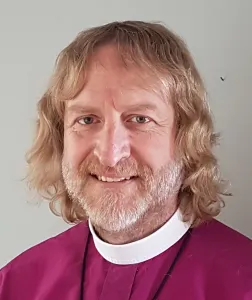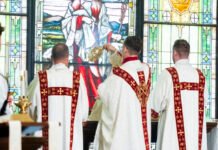From March 7 to 9, more than 30 Anglicans from across Canada will gather at a Roman Catholic retreat centre in Mississauga, Ont. for the last meeting of Council of General Synod (CoGS)—the executive body which carries out the work of General Synod, the church’s larger triennial gathering—before the latter meets in June. Staying in spartan lodgings that jar with the mansions that surround the retreat centre in Mississauga’s leafy Erindale neighbourhood, members of CoGS will gather to break bread, worship and, most of all, deliberate for two and a half days.
While it’s impossible to know precisely what decisions will be made at this month’s meeting of CoGS, one thing seems certain: much of the discussion that takes place there, and at the General Synod that follows this summer, will focus on radical structural changes that if carried out could change the Anglican Church of Canada forever. On the table, among other topics, will be the presentation to CoGS of findings from Reimagining the Church: Proclaiming the Gospel in the 21st Century, a primate’s commission tasked with re-examining church structures that has surveyed Anglicans across the country on a range of topics, including the potential elimination of General Synod or the ecclesiastical provinces and the cessation of funding for the Anglican Journal, at least as a journalistic entity.
If the church does take these steps, it seems unlikely to take them soon; at least, the commission itself does not appear in a hurry to initiate major change. In an email sent as this issue was being prepared in late January, Archdeacon Monique Stone, chair of the commission, told the Journal, “the commission has always envisioned that this work will continue beyond the short two-year time frame between General Synod 2023 and 2025. As such it has never been the intention of the commission to bring forward motions that will enact specific changes to canons and/ or structures at General Synod 2025.”
Instead, the commission has prepared a draft report laying out priority ideas or “pathways” in six areas based on the feedback it has received from Anglicans, which the commission’s chair says indicate a preference for refining rather than eliminating current governance structures. As of late January, these pathways, according to Stone, concerned:
- Organizational structures
- Management overview (and potential restructuring)
- Inclusion and diversity in decision-making
- Communications
- Walking in partnership with the self-determining Indigenous church (Sacred Circle)
- Ministry in vulnerable communities (Council of the North)
Stone said the commission will first present its draft report for consideration and possible revision at this month’s meeting of CoGS, with the intention of bringing the report and its pathways to General Synod as well.
Meanwhile, the Rev. Cynthia Haines Turner, chair of General Synod’s communications coordinating committee, says the committee will offer a report to CoGS about what the implications of any decision to end General Synod’s funding of the Anglican Journal would be.
Announcing the formation of the commission in 2023, Archbishop Linda Nicholls, then-primate of the Anglican Church of Canada, cited the need for the church to respond to a range of challenges, including financial pressures from the parish to the national level. Since then, the church’s financial problems have continued, with General Synod treasurer Amal Attia warning CoGS in November 2024 of a gloomy financial outlook in the face of declining contributions to the national church from struggling dioceses. The church is also grappling with membership decline, at least according to preliminary statistics for 2023—the most recent year for which they are available—which showed average Sunday attendance falling by nine per cent that year.
The third hypothesis, “It is time to eliminate one level of structure—either General Synod or the Ecclesiastical Provinces,” has met with rejection from some of the church’s most senior bishops, who told the Anglican Journal they would prefer instead to retain and streamline the church’s existing structures. The seventh hypothesis, “It is time to end independent editorial journalism funded by General Synod,” got a mixed reaction from CoGS when the council discussed it at its last meeting in November 2024.
Stone says in reviewing data on each of the hypotheses, the commission found that many gave rise to further questions, which in turn led them to propose the pathways as a way for the church to discern its priorities.
For example, she says, the seventh hypothesis prompted the question, “What are goals and objectives around communications and what are the tools by which we effectively communicate?” The commission incorporated such feedback into the pathways.
What would it mean to eliminate General Synod?
“Beyond the Hypotheses,” a commission document that explores the hypotheses in more depth, draws attention to the significant financial costs as well as time and energy of bishops, clergy and lay people required to maintain church governance structures at the national, provincial, diocesan, deanery and parish levels.
The commission suggests holding a consultation with the primate, metropolitans and representatives from CoGS and provincial councils to consider eliminating either General Synod or the ecclesiastical provinces “and/or a restructuring of responsibilities and resources between the two levels in order to more effectively support dioceses.” It also says consideration should be given to amalgamating dioceses or increasing collaboration between dioceses in administration and governance.
“In this time of institutional decline, with its attendant financial pressures, the Commission wonders if the church is ‘over-governed’ and wants to encourage conversations to re-imagine the church so that its core purpose of proclaiming the Gospel can be supported more vigorously,” the commission says.
In addition to being a gathering of Anglicans, General Synod is—unlike the Anglican Church of Canada—a legal entity; national office staff are the employees of General Synod, and lawsuits in which the church is involved name the General Synod of the Anglican Church of Canada.
Primate’s commission member the Rev. Cole Hartin—currently associate rector of Christ Church Tyler in Texas, and previously rector of St. Luke’s Anglican Church in Saint John, N.B.— says the commission was at first thinking mainly about provincial synods when it questioned the necessity of having three levels of synodical governance: dioceses, ecclesiastical provinces and General Synod. “It seemed to surprise me, anyway, that when we took in all of the surveys, there were more suggestions to get rid of General Synod than we had anticipated,” he says.
The Rev. Christopher Brittain, professor of Anglican studies at Trinity College, University of Toronto, says eliminating General Synod would potentially mean the end of the Anglican Church of Canada as a national presence.
“We’d have the Anglican Church of Canada in different regions, but they’d be really more regional independent churches than a national coordinated entity,” Brittain says.
If the church eliminates General Synod, Brittain foresees a scenario in which ecclesiastical provinces continue to talk to each other and coordinate—when they have time and when resources are available. “Initially there might be some capacity to hold together,” he says. “But that’s going to wither over time and fray.”
Without General Synod’s constitutions and canons, Canadian Anglicans would have to spend considerable time and money rewriting canon laws, he says. They would likely start to focus more on concerns in their own geographic regions. Brittain believes getting rid of General Synod would undermine both the functionality and reputation of the Anglican Church of Canada nationally, for example by making it more difficult for outsiders to contact someone who can speak for the church as a national entity.
As an example of why Anglicans might question the need for General Synod, Hartin— stressing that he was merely expressing his own opinion and not the commission’s—recalls the divisive debate at two successive General Synods over amending the marriage canon to allow for same-sex marriage. General Synod 2019 narrowly voted against the amendment after it failed to reach the necessary threshold of two-thirds support in the Order of Bishops.
“There’s been no change to the marriage canon of the Anglican Church of Canada,” Hartin says. “But concretely on the ground, most dioceses do same-sex weddings. I think progressives feel like, ‘OK, [General Synod] is holding us back. What’s the point of this anyway if we have the authority in dioceses to do what we want to do?’ And conservatives feel like, ‘What’s the point in having this kind of national structure and sets of canon law if we’re not going to honour them anyway?’”
Getting rid of General Synod, Hartin says, would mean the church in Canada would be left where it was before the formation of General Synod: with parishes, dioceses and ministry, but without many of the national resources it enjoys today. Anglicans in Canada “certainly would not have a sleek website or excellent national communication,” he said. “They would not have the apparatus that supports the primate.”
Hartin’s own view is that he does not want to see General Synod disappear. “It doesn’t seem prudent, because there are enough indispensable things that the General Synod does that I think would be really cumbersome to have to parcel out to other groups like the provinces,” he says.
“If [General Synod] did dissolve, then the provinces would have to beef up what they do, which would make us ask, ‘Well, if they’re doing all the things the General Synod did and taking the resources and time that took, what was the point in all this anyway?’”
Stone says both in receiving feedback as well as in members’ own opinions, the commission feels “it’s important that the Anglican Church of Canada remain part of the Anglican Communion… If the work that moves forward after General Synod is to explore whether maybe the provinces take on more work, or do we remove that element of governance, then some type of national body is going to continue to exist.”
Based on what the commission has heard from Anglicans, Stone says, she expects General Synod to invite the next phase of the commission’s work to “explore whether there needs to be a movement of roles and responsibilities amongst the different levels of governance,” rather than the removal of one level.
Rejecting ‘false dichotomy’ in proposed governance changes
In conversations with the Anglican Journal, senior leaders of three of the church’s four ecclesiastical provinces expressed a personal preference for restructuring over eliminating current governance structures. (Archbishop David Edwards, metropolitan of the ecclesiastical province of Canada and bishop of Fredericton, declined comment.)
Archbishop Greg Kerr-Wilson, metropolitan of the ecclesiastical province of the Northern Lights and bishop of Calgary, points out that General Synod does not have the jurisdiction or authority to eliminate ecclesiastical provinces, which existed before the national church.
“I think it’s really good to have a conversation about our structures and how we might use them more effectively or about what things might need to be eliminated,” Kerr-Wilson says. “But General Synod deciding that provinces should be eliminated would mean very little because it would end up being like, ‘Well, we want you to eliminate yourself, but [there’s] nothing we can do about it.’”
Stone confirms that dissolving an ecclesiastical province must take place at the diocesan and provincial level and is not a General Synod decision.
Any move to eliminate a level of structure “would have to be a collaborative piece of work,” Stone says. “From my perspective, the commission [is] saying if you are looking for efficiencies, given that the General Synod is a body that emerges [at] the request of the dioceses and in turn the provinces, is it time to have a conversation about looking at whether both levels are needed?” She notes that other denominations have removed a level of structure—citing the United Church of Canada, which changed in 2018 from a four-level to a three-level model of governance.
But Kerr-Wilson says even if ecclesiastical provinces voted to dissolve themselves, the Anglican Church of Canada would not likely become more efficient or save money by having General Synod handle tasks that were previously the responsibility of provincial synods. He estimates that the annual budget for the province of Northern Lights is about $100,000 and says dioceses’ annual contributions to General Synod are several times greater than what they pay for the provincial budget.
“If dioceses in the province of Northern Lights took all of the money that they give to the running of the province and gave it to the General Synod, it would make next to no difference to the overall picture, because it just isn’t costing that much to run the province,” Kerr-Wilson says.
Eliminating General Synod would also create problems, he says, though narrowing the focus of its responsibilities might help. “General Synod was created really as a pragmatic way of sharing resources and trying to get some things done that were difficult to be done at a more local level,” Kerr-Wilson says, adding that he views this as beneficial to the extent General Synod does things the church could not do otherwise.
The primate’s commission is “trying to start a conversation, and that’s great,” he says. “But I don’t think that’s likely to be the most fruitful thing, saying [we need to eliminate] one or the other, because it’s not likely to happen and also I don’t see that it creates that much by way of efficiencies.”
Read it all in the Anglican Journal



